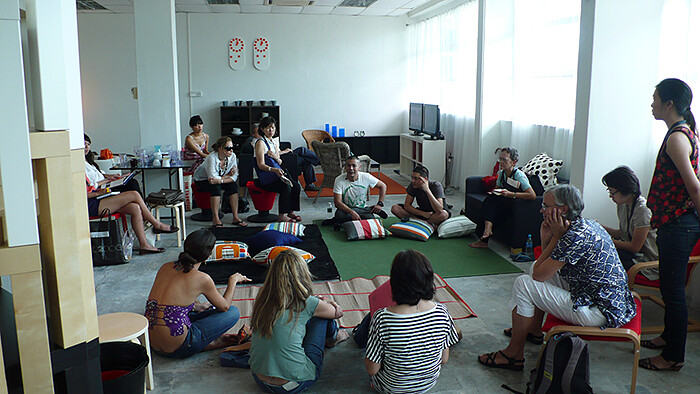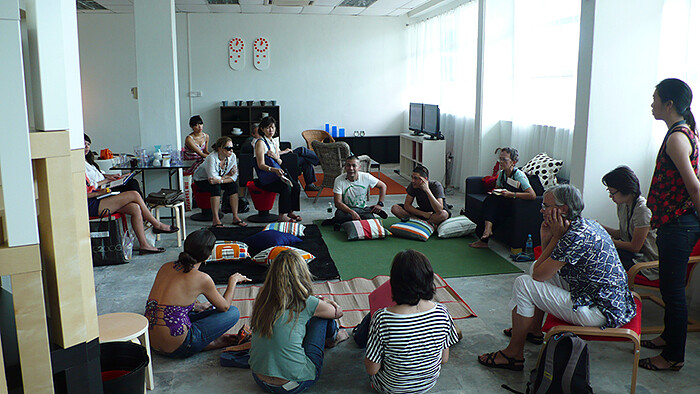March 13–May 15, 2011
The 2011 Singapore Biennale, under the artistic direction of Matthew Ngui and curators Russell Storer and Trevor Smith, gathers sixty-three artists from thirty countries in four different venue locations: the Old Kallang Airport, the National Museum of Singapore, the Singapore Art Museum, and Marina Bay. It is one of the more agreeable Asian biennial experiences I have had in a while, perhaps a result of its well-paced and smooth organization, with artworks clearly labeled and cogently installed. One comes to appreciate such details more and more, especially given that over the years the word “biennial” has grown synonymous for slapdash installations, bombastic curatorial frameworks, poor organization, and unintelligible or nonexistent verbiage. Perhaps it comes as no surprise that Singapore would present a polished exhibition so safe and measured that it not only obviates any stance or statement but leaves very little room for critique. Given the congenial tone and aesthetically pleasing yet neatly understated works, one could almost forget that it is a biennial at all. In fact, as I wandered through the show I kept finding myself wondering in what sense this show constitutes a biennial; and now, given the task of writing about it, I am forced to consider on what terms it is to be judged. Indeed these concerns point to a common conundrum within so-called biennial studies: that is, it may be easy to point to a multitude of opinions, but a set of common criteria has yet to be established to properly evaluate this genre of events*. At the end of the day, any given exhibition can only be properly judged upon whether or not it achieves what it sets out to do. But what if there is no discernible agenda, no readymade axe to grind? Or, in the case of this edition of the Singapore Biennale, if the nature of the show is so docile as to dissuade any clear reading?
If it were slightly more adept, I’d like to think that the 2011 Singapore Biennale might have offered a more inquisitive tone. Instead, it opted for an overly benevolent rubric of “Open House,” blandly described in the curatorial statement as “not only a gesture of hospitality and good will but also an opportunity to reflect, negotiate, and exchange.” Such an open invitation (one cannot properly call it a theme) amicably weaves across multiple regions and topical concerns, adroitly skirting substantial articulation. Regrettably, it stops short of declaring any position, however predictable that might be. Where the “Open House” rubric does succeed is in providing a backdrop for artistic encounters that are fair-minded if a bit safe, encouraging exchanges between artists and their “host” environment. If there is one constant to the biennial equation, it is the insistence upon “local specificity,” epitomized, for example, in Thai artist Arin Rungjang’s Unequal Exchange/No Exchange Can Be Unequal (2011), an installation at the Old Kallang Airport resembling an IKEA showroom which, in fact, doubles as a meeting place and exchange site for the local Thai community based in Singapore. During announced hours on weekends, members of this community—which the artist came to know during the several weeks he spent on-site—are invited to relax in the space and swap the assembled IKEA furnishings with things they decide to bring from their own homes, turning the bland set-up into an ad-hoc assortment of used objects invested with private memories and personal histories. Other works nearby take up more poetic means, such as Phil Collins’s elegiac video of skinheads in Kuala Lumpur, filmed in semi-documentary style and set to pulsating Welsh instrumentals. Collins’s work probes at notions of collectivity and shared identity as something circumstantial rather than ethnically defined. Upstairs, Danh Vo’s cardboard stack seems innocuous enough, but after learning that the gold-leaf letters adorning it correspond to military time zone abbreviations—details about Singapore’s coded past silently converge with endlessly shifting vectors of space and time.
Site-specific commissions such as these have a tendency to be hit or miss, and yet we are trained to welcome them, even when they verge upon hackneyed and superficial methodologies. One wonders how many more times the concept of a public garden developed in dialogue with local communities can be trotted out (Martha Rosler), and whether or not the act of replicating, adapting or incorporating one’s existing practice to include recognizable tokenistic elements of Singapore—Charles LaBelle’s “Corpus” (2010) from Buildings Entered, 1997-ongoing, or even Tatzu Nishi’s over-hyped The Merlion Hotel (2011)—can be seen to constitute substantial forms of engagement. Meanwhile, the three-screen video and sculptural installation All Lines Flow Out (2011) by Singapore artist Charles Lim strikes a chord not only for its eloquent visual style, but for ably linking Singapore’s water drainage systems to hidden dynamics of power and control that surround our daily lives. Ruangrupa’s entertaining installation Singapura Fiction (2011) at the National Museum of Singapore—an assemblage of old and new objects, images, invented narratives, and non-sequitur anecdotes mined from Singapore’s recent past—is a witty addition, borne out of a desire to see what materializes from the act of immersing artists in a specific (foreign) locality.
Biennales may remain imperfect places in which to look for answers to the world’s problems or to expect to solve the riddle of art’s capacity to effect change—but surely they can still act as sites in which certain questions can be posed. Robert MacPherson’s monochrome paintings borrowing street side advertising lingo may reference systems of exchange, consumerism, and labor but here they come across as weak and uncharged. Likewise, Shao Yinong and Muchen’s glimmering embroideries of defunct currency notes and Tiffany Chung’s immaculate architecture models—works which are the result of outsourced labor—appear simply a means to an end, hardly representative of the Biennials stated mandate to pay close attention to artists and their processes of making. The Propeller Group’s TVC Communism (2011) is a rare provocative work that involves enlisting big name advertising companies to create a television ad to sell the idea of communism to an unsuspecting public—yet ultimately the gesture suffers not only from technical difficulties, but from being trapped in an overly sedate set of circumstances. This is not to say that the artists or their works are necessarily at fault. Under the right conditions, the framework of an exhibition can help amplify meaning, and a biennial based upon being open and inviting might not be enough to edge the works into territories of real significance. In this case, discarding the usual biennial communiqués centering on global unrest and social or political urgency has the benefit of eliminating the need for each work to outdo the next, but if there is no urgency to the questions posed, responses may go unheard. I am reminded of Ruben Ramos Balsa’s installation, Untitled (Bulb), Pies de Plomo, Zapateado-Luz (2003-2007) tucked away in the bowels of the Old Kallang Airport: one enters a room that is darkened and empty save for the amplified sound of objects hammering against a hard surface. Looking up, one detects a tiny video of stamping feet projected within a lightbulb dangling from the ceiling—in an instant, aural and visual senses align and an imperceptible connection ignites.
*Carlos Basualdo, “The Unstable Institution” in Manifesta Journal No. 2, Winter 2003/Spring 2004. pp. 52. Also see Lee Weng Choy, “Dive Deeper—Biennales and Their Critics” in Shifting Boundaries: Social Change in the Early 21st Century, edited by William S W Lim, Sharon Siddique, and Tan Dan Feng, published by Asian Urban Lab, 2011.













